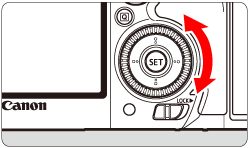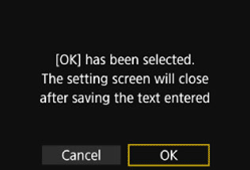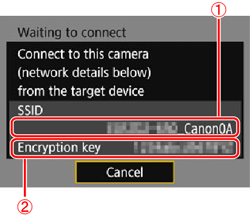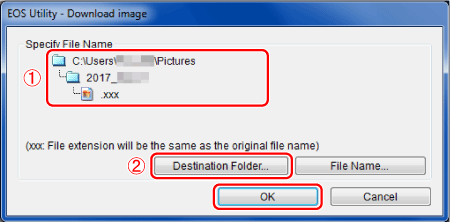Solution
Step 1. Preparing Necessary ItemsStep 2. Performing Basic Camera Settings
Step 3. Connecting the Camera to a Computer
Step 4. Sending Images to a Computer
Virtual Keyboard Operation
You can connect the camera to a computer with a Wi-Fi Adapter W-E1 (sold separately) and save images from the camera to a computer remotely using EOS Utility (EOS software).
This section explains how to connect the camera directly to a computer via Wi-Fi.

Caution
To connect using a Wi-Fi access point or connect manually in camera access point mode, see "Wi-Fi Adapter W-E1 Instruction Manual".
Caution
Step 1. Preparing Necessary Items
1. Check the camera’s firmware version.
Turn on the camera’s power switch. To check the firmware version, see the camera menu [ 

EOS 7D Mark II : Ver. 1.1.0 or later
Caution
If the firmware needs to be changed, refer to the Canon Web site.
Caution
When changing the firmware, remove the W-E1 from the camera. The firmware cannot be changed with the W-E1 installed in the camera.
2. Check the environment on your computer.
To check if your computer supports connection to a camera via Wi-Fi, refer to the "Related information" section below.
3. Make sure that EOS Utility is installed on the computer.
Caution
Settings may be disabled when an older version of software is used. Install a version of EOS Utility that is compatible with this camera.
Step 2. Performing Basic Camera Settings
The following settings must be performed before the camera's Wi-Fi function is used.
1. Install the W-E1 in the camera.
Set the camera’s power switch to ⋖OFF⋗, insert the W-E1 into the camera’s SD card slot, and a CF card into the CF card slot. For how to insert, refer to the Camera Instruction Manual.
2. Set the camera’s power switch to ⋖ON⋗.
3. Press the ⋖MENU⋗ button to display the menu screen.

4. Press the ⋖ 

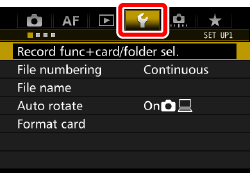
5. Turn the ⋖ 


Caution
If the camera’s auto power off is activated while connected, the connection will be terminated. If necessary, set [Auto power off] under the [ 
To continue to use EOS Utility, perform the reconnection procedure.
6. Turn the ⋖ 

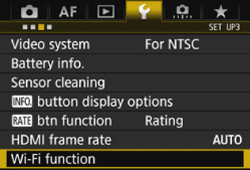
Caution
When this setting is selected for the first time, a screen to register a nickname is displayed.
When you are connecting the camera to another device wirelessly, the nickname will be displayed on the device. Be sure to set a nickname as otherwise you cannot set the wireless functions.
Select [OK], and then enter any characters between 1 to 10 characters in length.
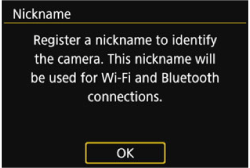
*For instructions on entering characters, refer to "Virtual Keyboard Operation".
When you are finished, press the ⋖MENU⋗ button.
Turn the ⋖ 

7. The [Wi-Fi function] screen will appear.
This concludes the basic camera settings.
Step 3. Connecting the Camera to a Computer
1. Turn the ⋖ 


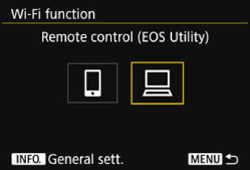
2. Turn the ⋖ 

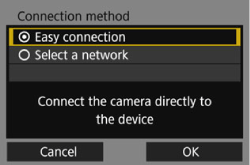
3. Turn the ⋖ 

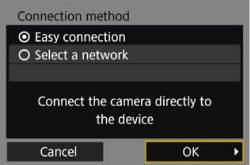
4. Operate the computer and connect it to the camera.
 ) displayed on the camera’s LCD monitor.
) displayed on the camera’s LCD monitor. ) displayed on the camera’s LCD monitor.
) displayed on the camera’s LCD monitor.Computer’s screen (sample)
Camera’s screen
Caution
When connecting by selecting [Easy connection], "_Canon0A" is displayed at the end of the SSID.
5. Select [OK] and press ⋖ 

6. The following message is displayed. "******" represents the last six digits of the MAC address of the W-E1.

7. Start EOS Utility on the computer.
 ] on the bottom left side of the [Start] screen. On the [Apps] screen that is displayed, click [EOS Utility].
] on the bottom left side of the [Start] screen. On the [Apps] screen that is displayed, click [EOS Utility]. 8. In EOS Utility, click [Pairing over Wi-Fi/LAN].
If a firewall-related message is displayed, select [Yes].
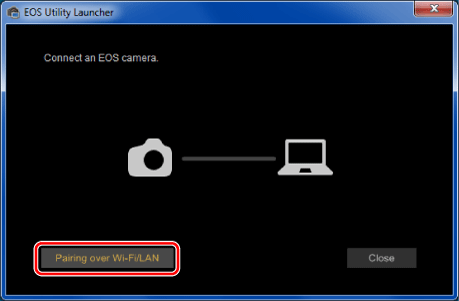
9. Select the camera to connect to, then click [Connect].
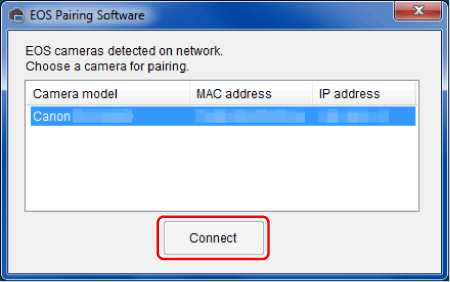
10. When the camera detects the computer on which you clicked [Connect] in step 9, the screen below is displayed.
 ⋗.
⋗.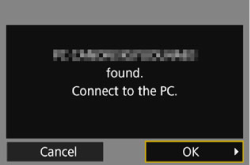
11. The [ 
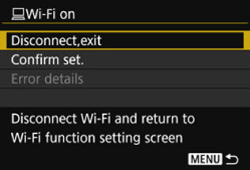
Caution
While connected, battery power is consumed. If you will not use the wireless communication functions for a prolonged period, terminate the connection.
Caution
Once pairing is complete, there is no need to perform pairing from the next time on if you continue using the same camera and computer together without changing the settings.
The settings for connecting the camera to a computer are now complete.
Step 4. Sending Images to a Computer
1. The main window of EOS Utility will be displayed, so click [Download images to computer].
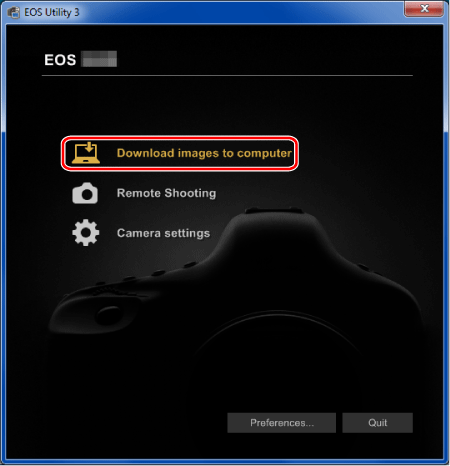
2. Click 

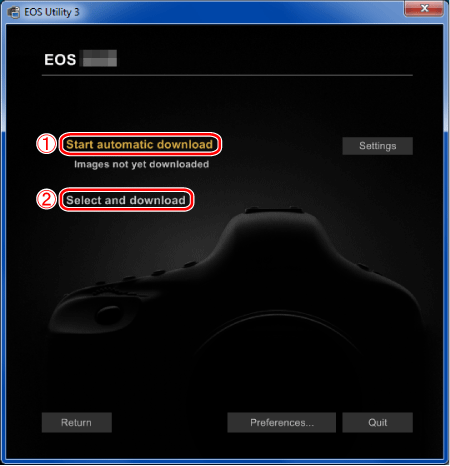
Caution
By default, the downloaded images are saved in the [Pictures] folder. You can change the save destination for images downloaded and images to download in [Preferences].
3. When [Select and download] is selected in step 2, the viewer window appears and the images in the memory card are displayed.
In the displayed list of images, checkmark the images to download and click [Download] (here, 4 images are selected).
If you selected [Start automatic download], proceed to step 5.
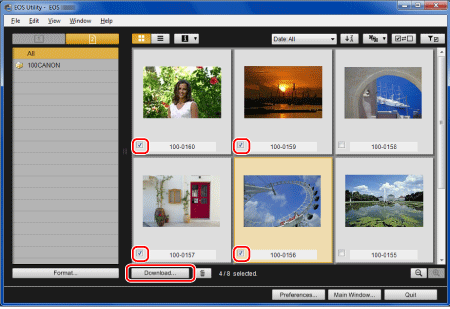
Caution
 ] to change the thumbnail order.
] to change the thumbnail order.  ] icon appears on the top left of the image.
] icon appears on the top left of the image.  ] to sort the images with various conditions and choose images you want to download.
] to sort the images with various conditions and choose images you want to download. 4. The [Download image] screen appears. Click [Destination Folder] and specify the destination, then click [OK].


5. The [Save File] screen appears. The images are downloaded to your computer.

6. When all images have been downloaded, click the [Quit] button to close EOS Utility.
Downloading images is now complete.
Virtual Keyboard Operation
When setting a nickname for the camera, use the virtual keyboard. For instructions on entering characters, see below.
The nickname can be changed later from the [Wi-Fi function] menu.
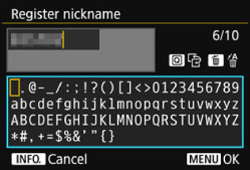
Press the ⋖
Use ⋖ 
In the bottom area, use ⋖ 

You can check how many characters you have entered and how many more can be entered by referring to [*/*] on the upper right of the screen.
Press the ⋖ 
Press the ⋖MENU⋗ button to confirm what you have entered and exit. If a confirmation dialog is displayed, select [OK] to exit.
Press the ⋖INFO.⋗ button to cancel text entry and exit. If a confirmation dialog is displayed, select [OK] to exit.









